Setting up Google Adwords remarketing
One of the most powerful contextual advertising mechanisms is remarketing (the term “retargeting” is often used). It is based on the principle of displaying ads in search and the Google Display Network to potential buyers who are already familiar with the product or brand.
What is Google Remarketing? Here’s an example. The visitor went to the website, but did not complete the target action – did not place an order, was not added to the mailing list, or did not register.
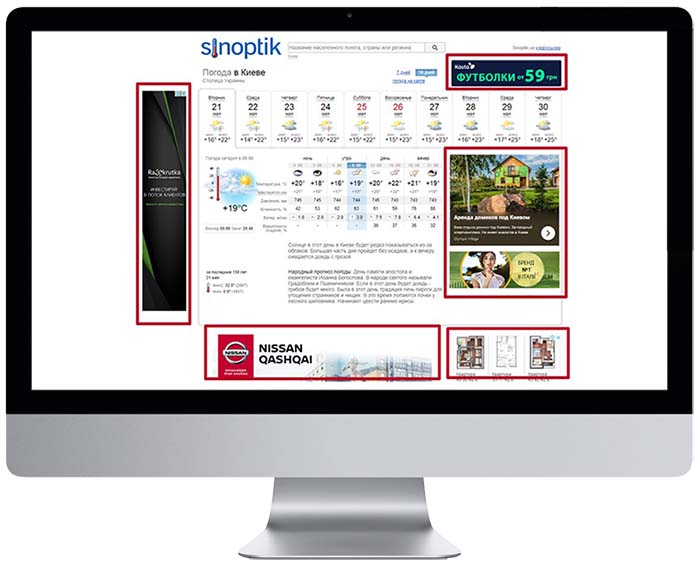

The system will add such a user to the audience that will be shown product ads on Google partner sites. This will remind the user about the product he was interested in and motivate him to take the target action.
How many calls and sales will I get by ordering contextual advertising from you?
I need to calculate the conversion of my website
Describe
the task
in the application
Calculate potential ad revenue
Google
contextual advertising calculator
Google Ads Remarketing Benefits
- Relevance. When remarketing lists are set up correctly, the user sees ads at the very moment when he is most ready to close the deal.
- Formation of lists based on advertising purposes. For example, this could be a list of website visitors who never made a purchase, or a list of users who added an item to their cart but didn’t pay.
- Wide coverage of target audience. Display Network allows you to publish advertisements on any partner site or mobile application, the number of which exceeds 2 million.
- Price management. Google Ads Remarketing helps you increase the ROI of your advertising campaign with automatic bidding strategies.
- Easy to set up ads. A large gallery of formats allows you to quickly set up ad modules in several modifications: text, image or video ads.
- Analysis of statistical data. Monitor the effectiveness and cost of advertising, track placements, etc. convenient thanks to reports.
- Brand advertising. Ads can be displayed on the screen of a user who is looking for information about your organization.
When should I order Google AdWords remarketing?
To date, this tool has become very popular. Ordering Google Adwords remarketing will be a good solution for:
- Keeping a potential buyer interested in a product. You can interact with users who have shown interest in a product or service but have not yet made a purchase. The period during which a decision is made to conclude a transaction varies from 5 to 30 days. In some cases, the process takes more than a month. It is very important to remind a potential client about yourself at the moment when he is ready to buy.
- Promotion of substitutes for a product or service. Such products fully or partially perform the functions of the product in which the user has shown interest. For example, someone who has studied the market for search engine optimization services can be offered contextual advertisements or SMM.
- Before-sales. This approach is applied after the first sale. In this case, related products are advertised. You can, for example, run ads for cases, software or headphones aimed at the buyer of a mobile phone.
- Holding a sale. During the sale period, it is advisable to target ads to those visitors who visited the site during the past year.
- Promotion of new products. The tool allows you to acquaint regular customers of the company with new products. With its help, for example, you can quickly recruit a group for a technical English course if you have previously trained specialists on the basis of your IT school.
- Increasing conversions. Users who have previously explored the site and become familiar with the brand tend to be more interested in buying than the new cold audience. Thus, by connecting remarketing, you increase the conversion rate, the number of orders and phone calls increases.
- Increase awareness. In some topics, a potential client needs several touches to close a deal. This is especially true for complex services, the B2B sector, the sale of real estate, cars and other expensive goods, and some medical services. Here, harassment advertising can significantly increase company awareness and increase sales.
- ROI increases. Due to cheaper clicks and high efficiency, remarketing can significantly increase the return on investment in an advertising campaign.
What types of remarketing can I set up in Google Ads?
Remarketing setup algorithms differ for different types of this tool. Let’s see how they work below.
Display Network Remarketing
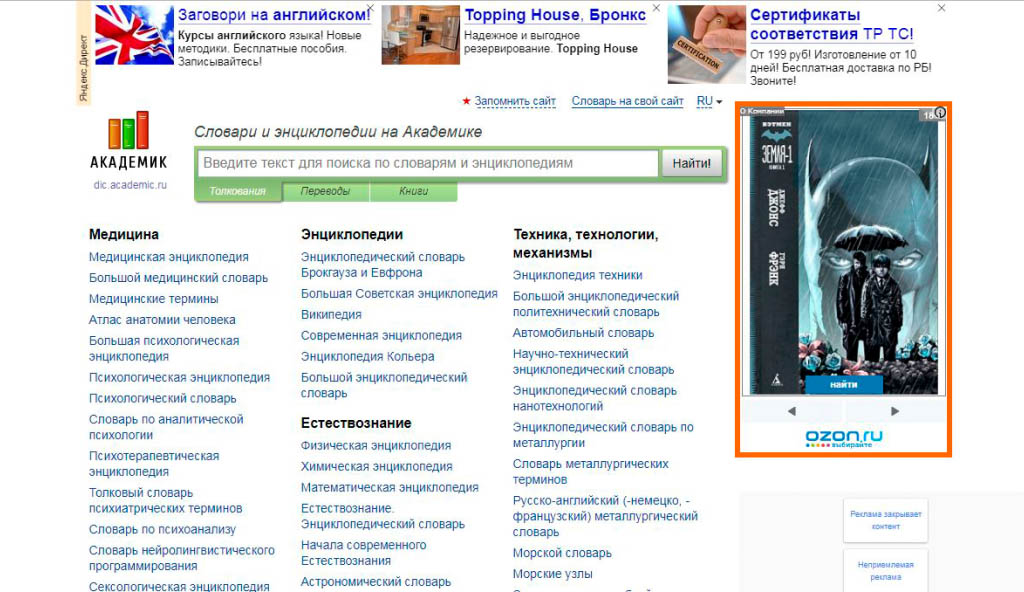
Display remarketing campaigns are aimed at visitors who have not completed the target action. Such users see advertising banners on partner web resources Display Network.
In order for this tool to work effectively, and the audience does not burn out over time, use the following recommendations:
- Organize A/B testing. Run several types of ads and evaluate the performance of each format. Find out which creatives perform better.
- Don’t flash too often. The optimal number of impressions is twice a day for one user. After the end of the testing period of the campaign, you will be able to adjust this frequency. It is possible that in your case you should show ads even less often. Or vice versa – you will be noticed only when the ad appears on the screen for the seventh time.
- Keep track of budget spending. Some sites sin by draining the advertising budget. To identify and disable them, open the Google AdWords start page and load the Placements block. Here you will find a report on the performance of the sites. Downvote the ones that don’t show any return.

Look-alike audiences
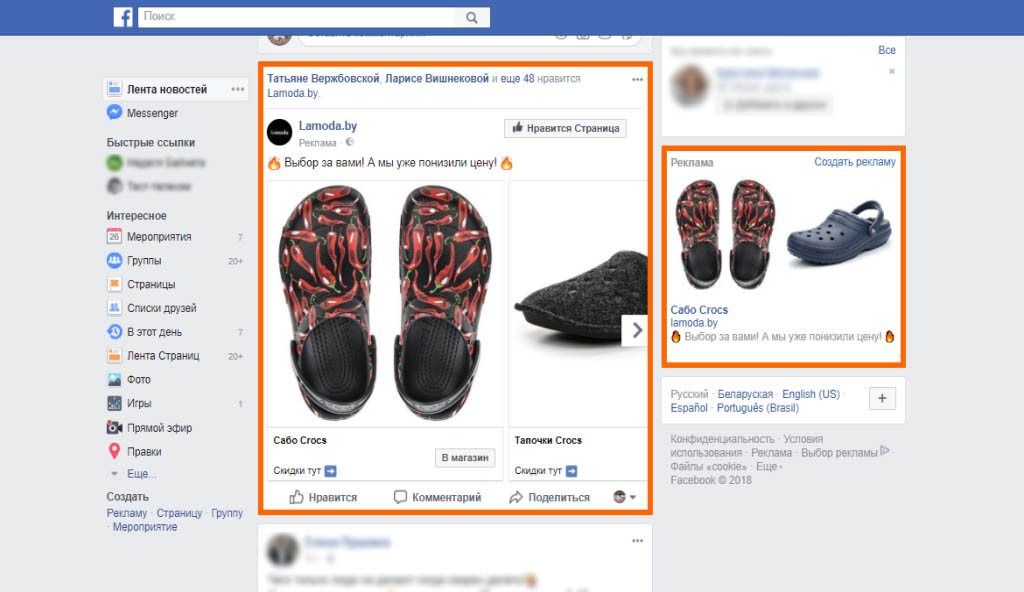
Selection of similar audiences is carried out by Google algorithms. They form groups of users who are similar in certain criteria to your customers. The main parameter for sampling is behavior – those who act in the same way as the selected group of customers are considered targeted. They like the same things, are interested in the same content, subscribe to the same channels and blogs.
The base list is mapped to all Google Audiences. Algorithms select similar users from it.
You can start compiling such lists in the “Audience Manager” module:
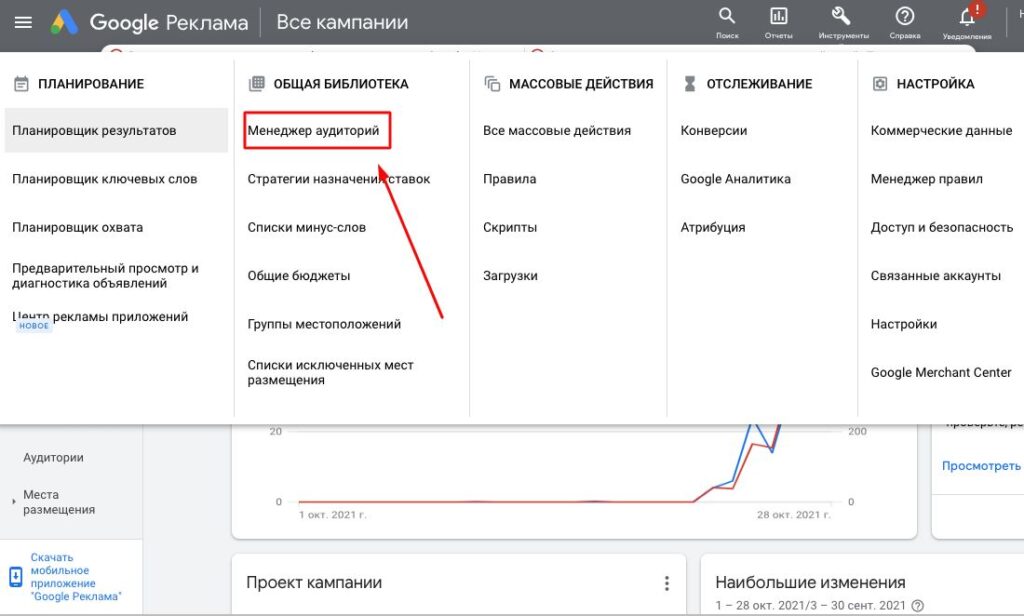
Start the formation of a new audience by clicking on the “plus” located at the top left of the screen. In the list that opens, click on “Custom combination”:
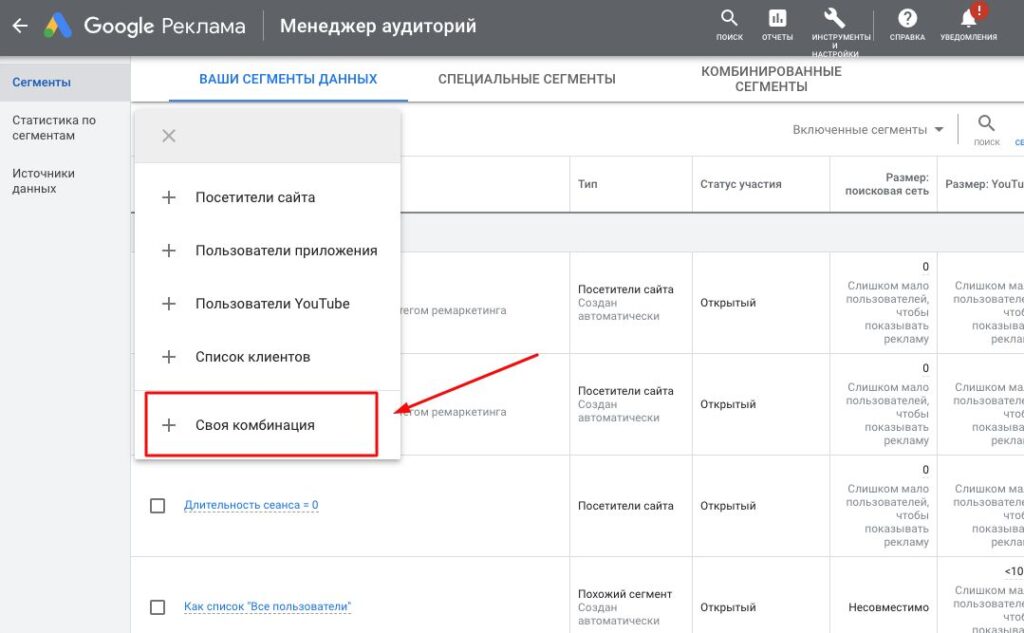
The next step is choosing options:
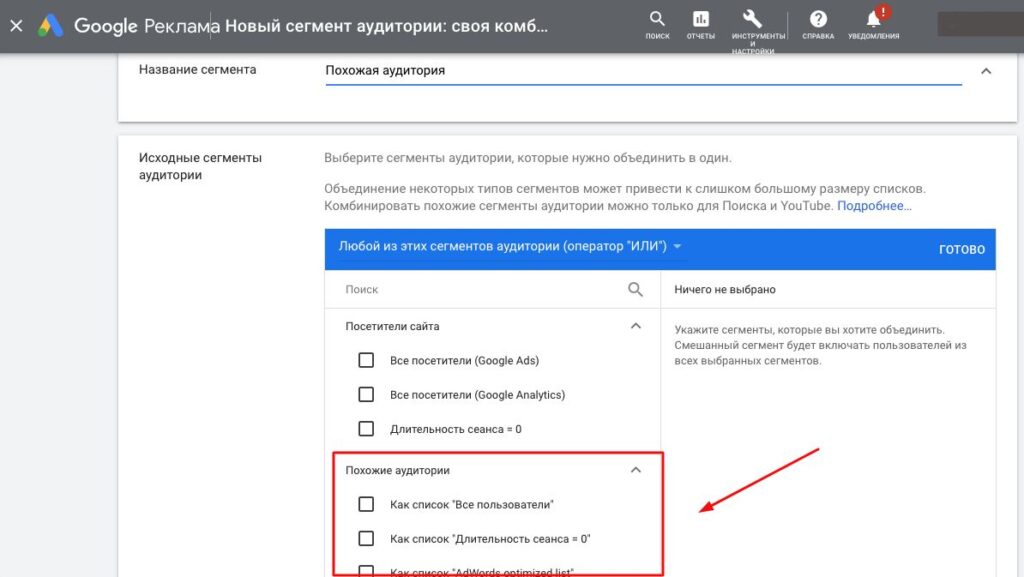
Advice! Lookalike audiences and remarketing tools are identical in terms of how they work. The level of detail of lists directly affects their quality. To narrow down the target groups, several parameters should be used.
Let’s demonstrate this with an example. There will be fewer users similar to those who made an order in your online store compared to the audience formed in the image and likeness of all site visitors. At the same time, in the first case, the conversion rates will be higher, so it is reasonable to set higher rates for such a group of potential customers.
Search remarketing
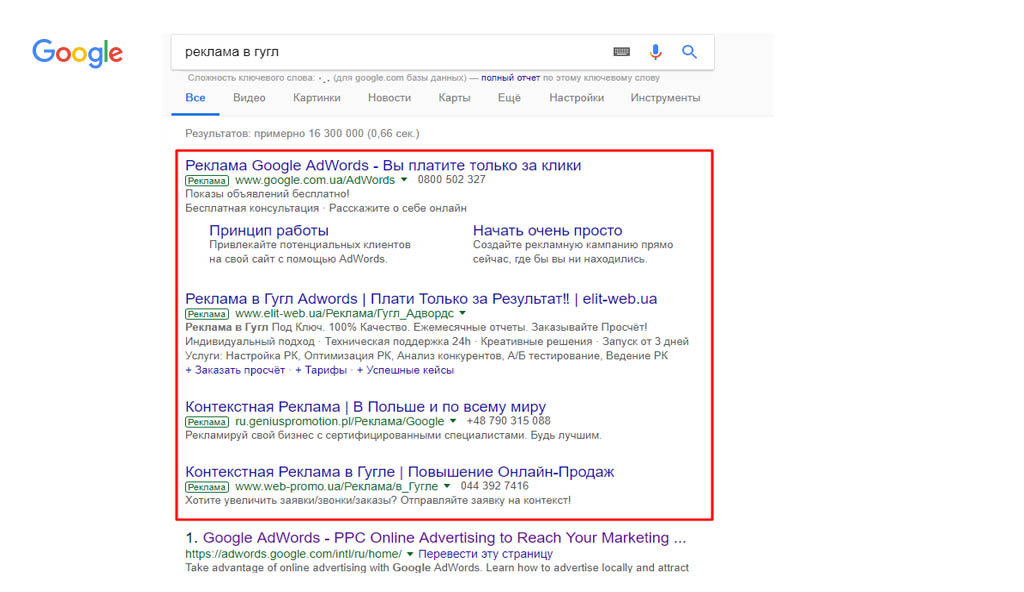
Ads of this type appear next to organic results in Google search.
Search remarketing allows you to flexibly adjust your bids. You can, for example, increase your maximum cost per click when showing ads to loyal buyers in the hope that users who are familiar with the brand are more likely to close the deal than those who have never seen the offer before.
At the same time, it is advisable to lower rates for visitors who regularly visit the site, but do not perform the targeted action. These may be employees of competing companies that monitor prices.
When setting up search remarketing, consider the following points:
- Don’t make a copy of the semantic core you use in your search campaign. By using remarketing, you limit impressions by default, and a large list of keywords and negative keywords further narrows the target audience.
- Launch an attention-grabbing promotion. It is not enough to issue a relevant ad – you need to act more subtly.
- Don’t repeat the ad. Exclude list remarketing from ad campaigns powered by search.
Retargeting based on email
These ads appear when you visit your email account, as well as YouTube and search.
Email remarketing is worth using:
- If you already have a database of email addresses whose owners do not make purchases.
- If your audience is characterized by a large proportion of those who open emails but do not order goods or services.
- If you need to promote a product among unsubscribers. You cannot send letters in this case, but no one will forbid you to show advertising messages to such an audience.
- If deals have a long sales cycle. This situation is observed, for example, in the real estate market.
Important! Many advertisers point out that email remarketing is a more sensitive form of communication than email marketing.
When setting up this tool, sometimes you should exclude impressions for regular customers. This does not apply when it comes to cross-selling or special discounts for this category of users. Otherwise, you will waste your budget on an uninterested audience.
Dynamic Remarketing

This type of retargeting is relevant for businesses with a wide range of services. Examples of such companies are distance learning courses or a recruiting service.
The user will see advertiser-selected pages or specific content on the site. For example, items viewed or added to cart.
At the heart of dynamic remarketing is such an impact on a potential buyer, in which he remembers about earlier the actions taken, as well as the emotions associated with them.
Important! The tool is rightfully considered the most difficult to set up, since it is not enough to form only the target audience to launch it.
You need to upload a file of a certain format (feed) to the system, containing all the information about the assortment:
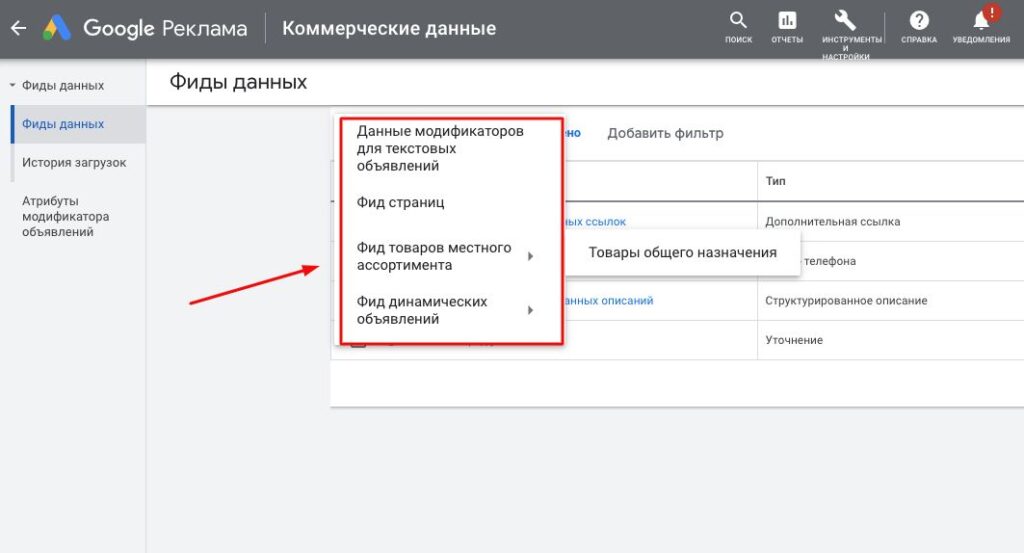
This is done via the “Commercial Data” link in the “Settings” module:
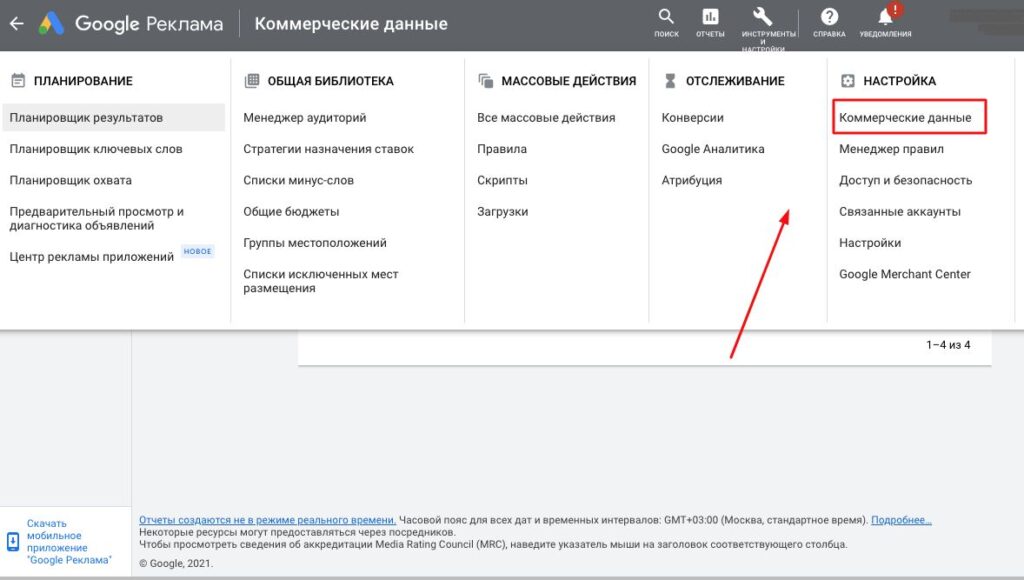
Google allows you to create a feed with data not only about individual products, but also about product categories. The second method is relevant for stores with a limited range of items sold.
Ads-Harassment in Apps
To activate remarketing in apps on smartphones and tablets, you need to upload a list of mobile identifiers to your account. The system will allow you to do this only if the application and the AdWords account are integrated. If you haven’t already established such a link, create it during the process of building a new audience.
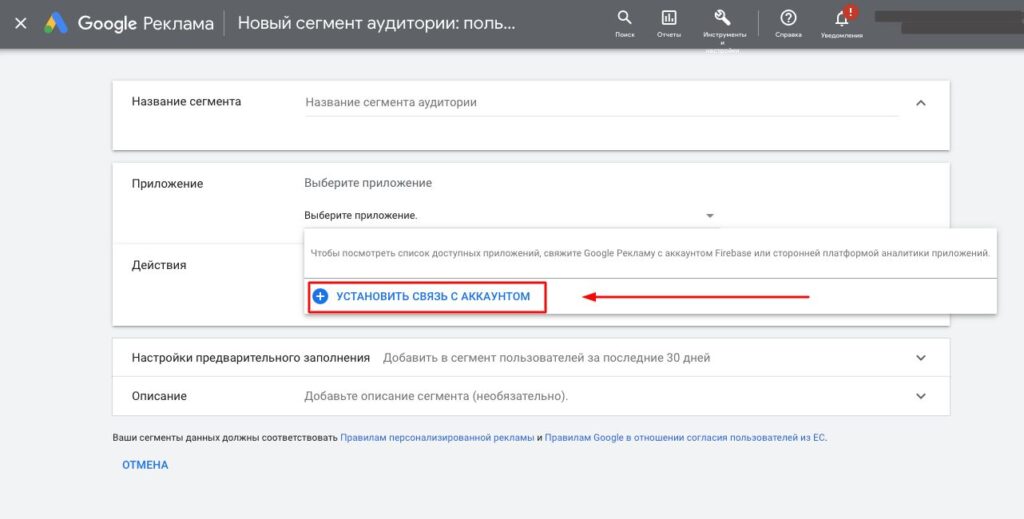
Video Retargeting
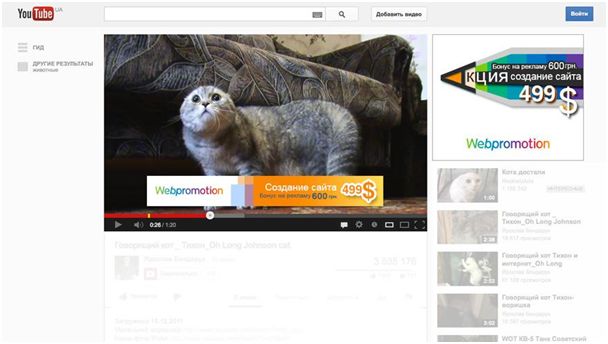
By analogy with retargeting in the Display Network and search, create a list of those who have watched videos on your YouTube channel and set up ads for them in other sections of the portal, as well as in applications and Display Network.
Information! The service offers the ability to show impressions on the selected channel or on certain of its videos.
Let’s say you want to promote an online seminar. To do this, targeting can be set up for those who are interested and watched the speaker’s speech, but have not yet read the commercial of the seminar itself.
Remarketing for Google Shopping
This tool helps to significantly increase the number of conversions and increase the effectiveness of the AC. There are two types of remarketing for Google Shopping:
- Observation – Ads are visible to all users, but the remarketing audience bid is higher. This opens up the possibility of placing ads for this group in a higher position.
- Targeting – Only those who meet the criteria of the remarketing campaign will see your ads.
Advice! Both options can be quite effective. The choice in favor of one of them must be made depending on who needs to direct the marketing impact – to a hot audience or located further from the deal in the sales funnel.
Tiered or Cascading Remarketing
To set up remarketing in Google Ads for campaigns with a total traffic of more than 5 thousand visitors, you should work out a strategy taking into account the buyer behavior funnel.
Let’s give an example of classic sales funnel:
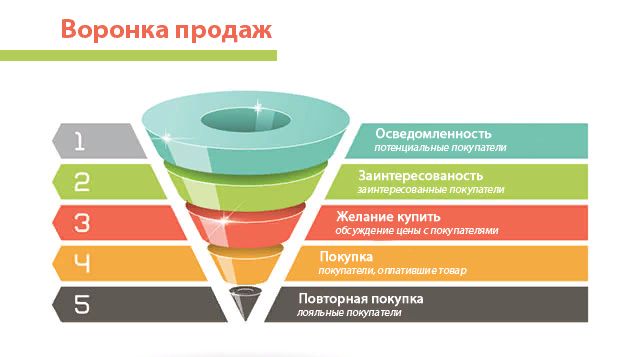
The main task of the contextologist here is to form remarketing lists that motivate a potential client to move down the funnel. At the same time, it is necessary to expand each of its levels.
One or more remarketing lists must work at all stages.
Variable values depend on funnel level:
- CPC (Cost Per Click): The more important your audience is, the more you can pay per click.
- Cookie duration: For audiences at the bottom of the funnel, the retention period should be longer.
How do you set up Google Remarketing?
Setting up remarketing in Google AdWords is not possible without linking your Analytics account to your AdWords account. Make sure the systems are interconnected and working correctly. If you have any difficulties at this stage, use the appropriate instructions.
Go to your AdWords account start page and click on Tools & Settings. Next, click on the link associated with audiences:
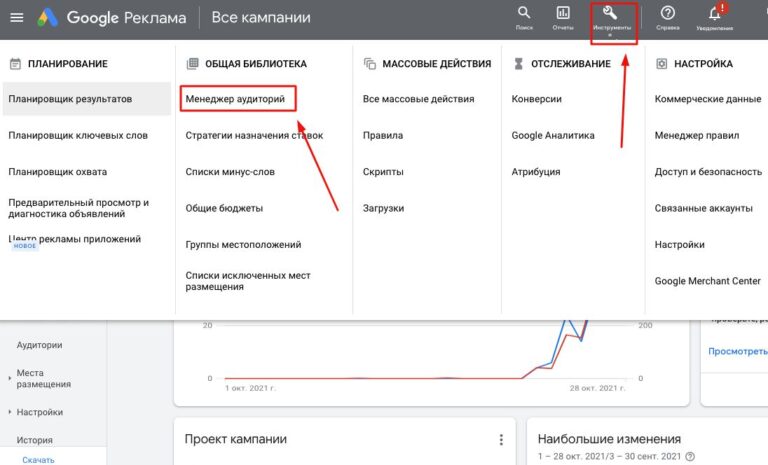
You will see these sub-items:
- data sources;
- segments;
- segment statistics.
If we want to limit ourselves to the standard setting, then it is important for us from which source the remarketing tag will receive information.
Open Data Sources to see which integrations are already implemented. If the above list does not include Google Analytics, then use the “Connect” link:

Check if all required data sources are properly connected.
Set up the tag using the appropriate link in the “Google Ads Tag” block:
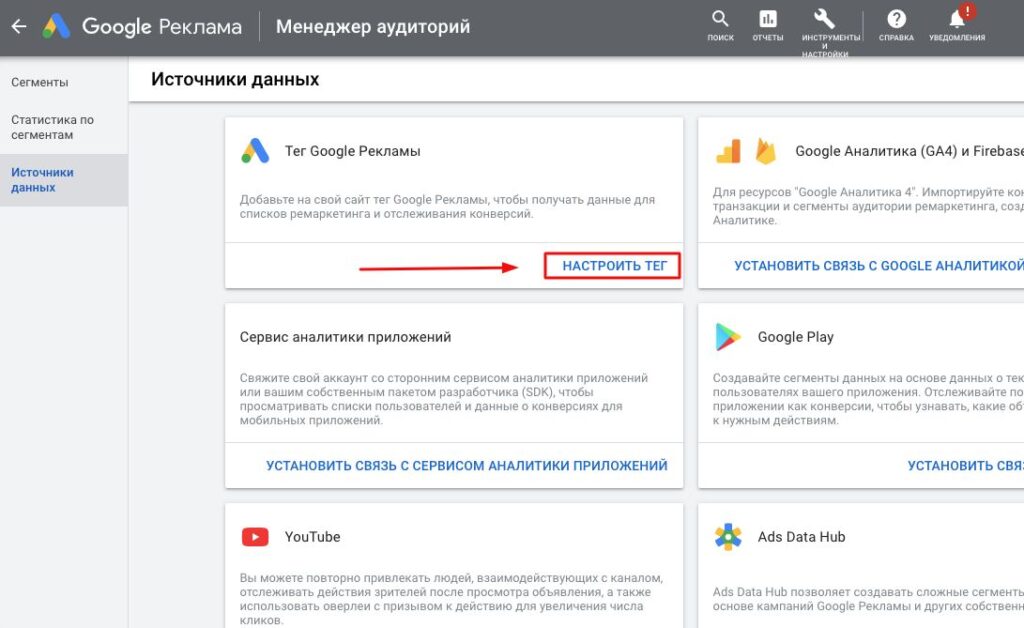
Next, you need to decide what kind of information the system should collect: exclusively about site visits or about specified actions. The first option is used to enable remarketing for all users.
By selecting the second option, you will be able to display ads for those who ordered a callback, looked at the location map on the site, added the product to the cart, but did not buy, etc.

Check all the necessary positions and save the settings. Tag is ready. The algorithm will give three ways to add it. You can:
- Add the tag to the site code yourself.
- Forward it to an e-mail to an IT specialist.
- Use Google Tag Manager.
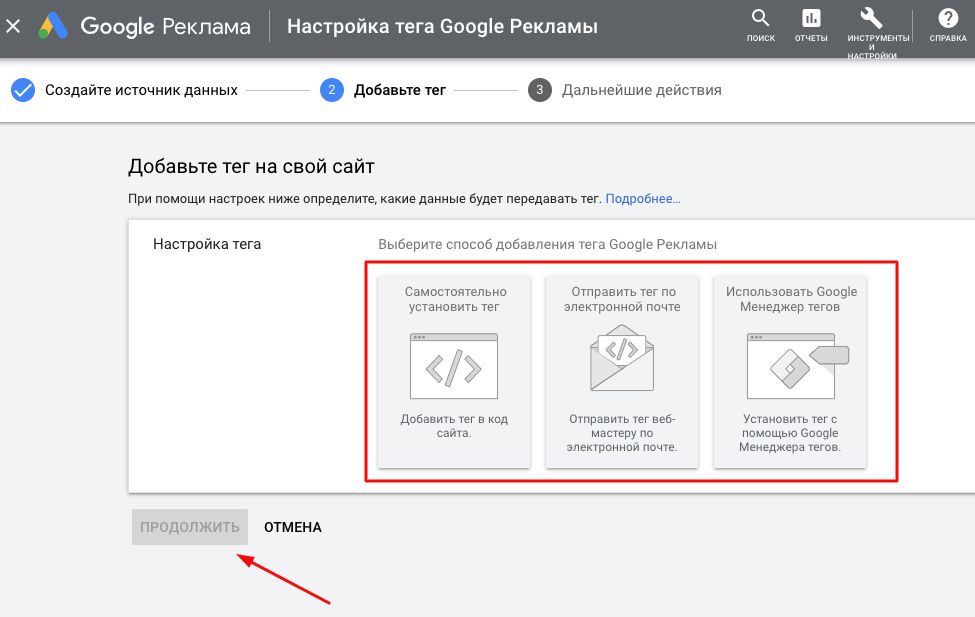
Decide on the most suitable method for your situation and proceed to the next step.
You can control the correct operation of the tag in the “Audience Manager” block, where the algorithm will generate combinations of users.
Here you can create not only standard audiences, but also group visitors according to your own parameters.
As an example:
- Create a retargeting audience based on the visit criteria for a given page of the site to limit the group for displaying ads.
- You can also create an audience from mobile app users. In this case, it is necessary that the advertising account be associated with Google Play in order to download the list of device identifiers. It is important not to forget to update the list periodically, because the structure of application users is changeable.
- Use a file with your own list. For example, a list of regular customers of the company.
- Create an audience of subscribers or viewers of your YouTube channel by integrating it with your ad account.
For the remarketing tool to work correctly, the system must be able to collect data on at least 100 visitors per month. Moreover, any of them must meet the selected criteria. The procedure for setting up a remarketing advertising campaign is practically the same as the standard one. The only difference is that you need to add a remarketing list.
Google Ads Retargeting Tips
- Estimate the length of the decision period. Determine how long it takes a user to complete a conversion action from the first visit to the site. This will allow you to get more detailed information for the formation of audiences. You can download this data in the “E-commerce” section of the Analytics service.
- Use Google Ads remarketing lists for exclusions. The idea of not showing ads to those who, through their actions, have already demonstrated an intention to purchase a product, but have not completed the purchase, may seem strange. However, this way you can focus all your efforts on attracting a new audience and not spend your budget on visitors who are already familiar with the site.
- Use smart lists. This type of remarketing list is generated by Analytics based on conversion information. The algorithm determines the probability of a purchase on the next visit for each user. Using smart lists helps increase your conversion rate and eliminates the need for self-monitoring of the audience.
- Swap audiences with partners. Such interaction is common, for example, among representatives of the insurance and tourism businesses. Sharing remarketing lists opens up additional opportunities for companies. To use the tool, you must fill out and sign special forms that Google sends upon request.
Popular questions about the tool
-
You can collect information in remarketing lists from several sites, but to display ads to a general audience, you must select one site.
-
The collection of data about the audience of a site is carried out only after running a special code on this site. That is, in the absence of access to the administration of a web resource, it is impossible to collect information and show ads to its visitors.
-
The most important advantage of retargeting over search advertising is the low cost per visitor to the site and the relatively high conversion rate.
Additional functions of this tool include the ability to motivate a potential buyer who is just one step away from closing a deal to purchase a product. Many do not use bookmarks in the browser and after a while they cannot remember the website address or the name of the online store where they found the product or service.
Parallel use of remarketing and other advertising tools makes it possible to significantly reduce the cost of the target action and increase the effectiveness of the campaign.
-
The most difficult thing to set up is dynamic remarketing. When you create it, you need to upload a feed of data about products in stock into the system. High audience granularity complicates remarketing setup.
It will take the least time to generate a list of all visitors to the site, regardless of the result of their visit. But if you need to select from them those who placed the product in the basket, then you will need to make much more effort.

